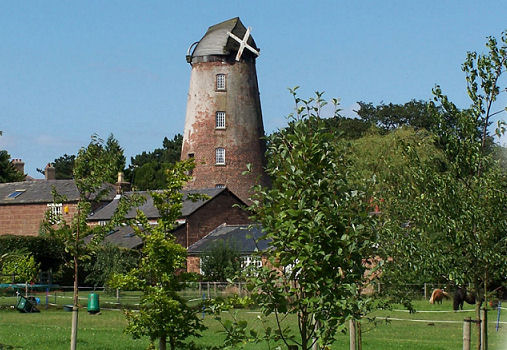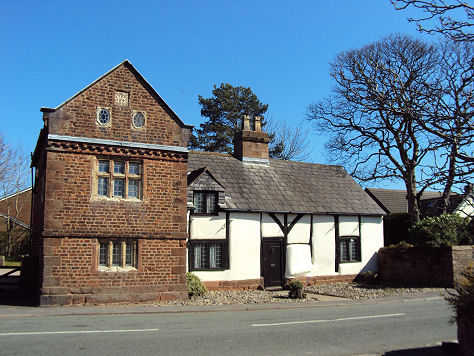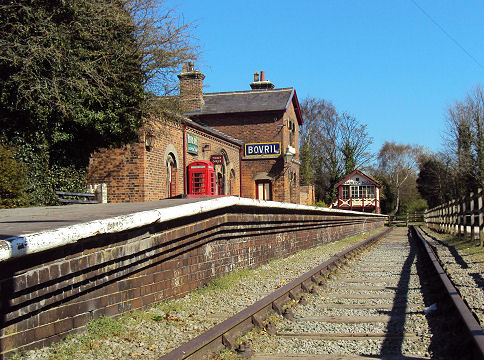Willaston
OS Grid ref:- SJ330777
The village of Willaston is located between Neston and Ellesmere Port on the attractive Wirral Peninsula. The name Willaston derives from the name for the Wirral Hundred, the peninsula's former administrative division.
Willaston Windmill

Willaston Windmill, which dates to 1800, was the largest windmill on the Wirral. It was once used for the production of flour and to grind cattle food. It remained in operation until about 1930, when its sails were destroyed in a storm. The windmill has also now been converted into a private house. One of its millstones now forms the main feature of the village sign on the Little Green.
The village is centred by its village green, the Red Lion, a half timbered building which overlooks the green, dates back to 1631, it remained an inn until 1928 but has now been converted to a private house. The Nag's Head, which stands nearby, was built in 1738. Willaston has a number of fine 17th century buildings, including the highly attracktive Ashtree Farm
Ashtree Farm

Willaston Old Hall bears the date 1558, but has many alterations of later date, the red sandstone hall consists of five bays, with three storeys and has attractive mullioned and transomed windows.
Hadlow Road Station on the Wirral Way

The now disused Hadlow Road railway station, which once served village and now stands on the Wirral Way, dates to 1866, the station, platform and signal box have been lovingly restored to their condition in 1952.
Christ Church at Wlliaston was founded in 1854.
A walk from Willaston to Parkgate
Distance- 8.5 miles
*Commencing at the Wirral Way car park in Willaston, walk along the platform and cross Hadlow Road to join the Wirral Way. On reaching a narrow wooden bridge which crosses a farm track, cross the bridge, proceed down the path on your right and curve back under the bridge. Follow the track, which passes through a gate and becomes narrower. Continue round to the right where a footpath is marked on the left. Another footpath soon crosses and you go left here.
*On arriving at Woodfall Lane, turn right and follow the track to the point where Gorstons Lane joins from the right. On the left here, take the footpath past the children's playground, cross over a stile and continue across the field. Near the far edge of the field, the way goes round to the right, past a house on the right, into Cumbers Lane.
*At the end of Cumbers Lane, go left onto Neston Road. Turn right at the Wheatsheaf pub into Well Lane, About 400 metres along the lane, turnn left onto a broad, pass under a railway bridge, turn right and continue until you arrive at the old Denhall Quay.
*On reaching the Old Harp Inn , go along the edge of the marshes. Cross a small bridge to arrive at Neston Old Quay. Where a house blocks the way, turn right and then left along Manorial Road. This turns into a path and then another road, at the end of which go left down a short narrow path, which comes out at the extreme end of the Parkgate quay. Go right past a slipway onto the main part of the waterfront.
*Walk along the front and turn right up Coastguard Lane by the chapel. Follow the road until arriving at the Wirral Way. Turn right onto the Way and follow it for some way until you reach a red-painted bridge in Neston. Keep straight ahead under the railway bridge and up the suburban road that follows alongside a park on the left. At the top of the road, the Wirral Way starts up again.
*Pass through a deep narrow cutting which spreads for a distance. On emerging from the cutting you will soon reach the point where you left the Wirral Way earlier, from here retrace your steps to the starting point in Willaston.
Nearby places of interest
The National Waterways Museum at Ellesmere Port, is situated at the northern end of the Shropshire Union Canal where it enters the Manchester Ship Canal. It contains the largest collection of canal boats in the world. With its fascinating displays housed in a fine collection of Victorian buildings, the museum makes a great day out whatever the weather.
The Blue Planet Aquarium at Ellesmere Port is the largest aquarium in the UK, and boasts two floors of interactive displays and exhibits. The Blue Planet holds more sharks than anywhere else in Britain, holding more than ten different species from around the world including sand tiger sharks.
Brotherton Park, a nature reserve, is a one of the finest examples of ancient woodland on the Wirral and once formed part of the Royal forest of Wirral dating back to the end of the last ice age. Other habitats on the reserve include wildflower meadows, reed swamps and historic parkland. Brotherton Park and Dibbinsdale comprises of 47 hectares of semi-natural countryside along the valley of the River Dibbin.
Eastham Country Park is situated on the banks of the River Mersey, the park covers a hundred acres and contains some of the finest mature trees to be found on the Wirral. The park offers excellent views across the estuary and the cliffs at provide superb sites for viewing the flocks of waders and ducks on the estuary. Much of the Estuary is now designated a Site of Special Scientific Interest.
